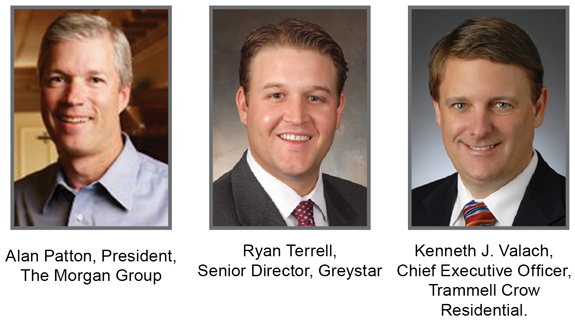Houston’s Commercial Real Estate Market Will Continue to Flourish in 2014
Positive forecasts combined with continuous optimism was the consensus of participants during the 2014 CCIM Forecast Competition on Feb. 6 at Granite Properties’ newest building, Granite Briarpark Green, in Westchase. The annual competition offers two perspectives on market trends by local experts in the office, retail, industrial, land and multi-family markets. Sponsored by the CCIM Houston/Gulf Coast Chapter, a moderator for each land use kept the conversation flowing by asking specific questions of each participant.
Dr. Mark Dotzour, Chief Economist at the Texas Real Estate Center at Texas A&M University, offered a positive outlook for both Houston and the state. “The Houston business cycle index shows continuous growth with the energy/oil and gas sectors rate of growth slowing some,“ Dotzour said.
He said the reason we continue to grow in Houston and Texas is because of the environment where business leaders are welcoming. Most major employment sectors have experienced growth in the Houston metro area during the last 12 months, with retail trade and professional/business services growing more than 4%. Even government jobs are up slightly in the area.
Home sales in the area are up a total 18.8% from 2012, with the average sales price increasing 10.3%, according to the Houston Association of REALTORS®. The problem is a lack of inventory in both Houston and statewide, according to Dotzour, and part of the problem is lack of qualified labor to build houses. He explained if inventory doesn’t increase, “prices will go up so much, we will lose our competitive advantage of being able to live comfortably here.”
He cited several positive ways Americans are handling their incomes that are contributing to the economy:
- Consumer confidence is increasing and personal consumption expenditures are increasing.
- Consumers continue to pay down debt. This is the first time in 50 years that the personal debt has not risen.
- Americans’ net worth has never been higher.
- Household debt service payments, which determine the percent of disposable income, are decreasing so we have the ability to buy what we want.
- Corporate profits and hiring plans are also up.
Land
Moderator: Frank H. Fitzgerald, CCIM, Senior Vice President, NewQuest Properties.
Contestants: Keith Edwards, SIOR, CCIM, Senior Vice President, Caldwell Companies, and David Marshall, Principal, ARA Land.
Both Edwards and Marshall agreed that land sales in 2013 were very active compared to the previous few years. They also agreed on the forecast for a “bright” 2014 market with pricing staying strong due to the positive economic conditions of job and population growth in the area.
Both noted strong land sales in both infill Houston and in the suburban markets, with the Northwest area, ranging from Interstate10 all the way to Highway 59 and up to Conroe, leading the way due to the ExxonMobil development. Investors, many from out of the state, have been active in the area since Houston is now being described as a “gateway” market, but the area’s job growth and population increases have fueled the expansive development.
Both competitors cited challenges to development:
- Scarcity of good sites with utilities in place. However, even if utilities are available, many times the price is too high.
- Rising costs of land and development materials
- Competition from other developers, with many arriving from out of state.
- Transportation issues, although the Grand Parkway extensions will open up all areas in the Northwest, especially in the 290 Corridor.
Marshall predicted higher costs for all land segments than Edwards, pricing midtown land per square foot 25% higher, $72.50 vs. $58.00, and suburban land sites from 100 to 250 acres 24% higher, $40,000 vs. $34,250 per acre. Edwards predicted 29,850 single-family starts in 2014, while Marshall predicted 32,000. However, Edwards believes more lots, 31,750, will be developed while Marshall said 26,500 lots will be developed.
Multi-family
Moderator: Alan Patton, President, The Morgan Group.
Contestants: Ryan Terrell, Senior Director, Greystar, and Kenneth J. Valach, Chief Executive Officer, Trammell Crow Residential.
The consensus: Houston’s solid job growth and nation-leading population growth are spurring new apartment development throughout the Houston area. These well-paying jobs for new tenants are helping to support the increasing rents with few concessions. Both experts said they are seeing some softening in select markets but “we aren’t too worried” about over-building at this stage. The strongest markets in the city include the Medical Center, the Heights, Midtown, the Washington Corridor and The Woodlands.
Predicted rents this year range from $1.64 to $1.67 per square foot for Class A and from $1.08 to $1.12 for Class B. Terrell forecast apartment absorption to total 14,000 units with an 88.5% occupancy in Class A and a 95% occupancy in Class B, while Valach predicted absorption of 16,500 units and occupancies of 91.9% for Class A and 94.7% for Class B.
Due to Houston’s current “gateway” city status, the city has been on every investor’s radar and interest has been “extremely high” during 2013. Higher prices for new construction can be justified in the better markets, so investment activity will remain strong in 2014, they predicted.
Both contestants shared some trends they are seeing in the multi-family market:
- Student housing is up, with more and more amenities being added.
- Highrises are definitely on the rise.Apartment mix is changing to more one bedrooms.
- More mixed-use environments are being developed along with senior developments.
- More people are staying in apartments longer.
- Tax incentives are assisting with increased multi-family development in the Central Business District.
Industrial
Moderator: Bill Byrd, CCIM, SIOR, Principal, Colliers International.
Contestants: Rusty Tamlyn, CCIM, SIOR, Senior Managing Director, HFF, and Justin E. Bennett, Regional Vice President, DCT Industrial
Houston’s industrial market is doing well, with occupancies as high as 95% for dock-high space, both contestants agree. They also noted one major change in the current tenant base: previously almost all space was leased by energy-related firms, but now more consumer-use players are occupying the warehouses along with the e-commerce tenants like Amazon, who require design differences including multiple racking systems. Consumer-use tenants supply consumer goods such as furniture, appliances and mattresses along with food companies like Ben E. Keith and Goya. The former industries will “explode,” requiring even more space, when home building increases, they said.
Both contestants predicted industrial space to be similarly leased in 2014, with occupancy ranging from 93.9% to 94.6%. Market rental rates forecast for dock-high space range from $4.62 to $5.16 per square foot with $5.00 to $6.25 tenant improvement costs allowed for Class A, and from $3.60 to $4.32 rents per square foot for Class B with tenant improvement costs projected at $1.75 to $5.00 per square foot.
Class A flex space is looking at rates from $9.25 to $10.80 per square foot while Class B is projected from $7.00 to $7.20. Tenant improvement costs for flex space are projected from $30.00 to $35.00 for Class A and $20.00 to $22.50 for Class B, with higher costs attributed to a trend toward more office space being completed in some projects. The two experts didn’t vary too much on absorption: Tamlyn predicts about 6.5 million square feet of absorption while Bennett predicts almost 6.9 million square feet.
Development continues by the local offices of national REITS, but now include joint projects with private or “merchant” builders. By the end of 2013, more traditional development was occurring. Since completing industrial projects is a lot quicker than other asset types, the probability of being overbuilt lessens, they said. However, if the private builders re-emerge, oversupply will need to be checked, Bennett said, although he pointed out that at least 30% of all space delivered in 2013 was pre-leased.
Both agreed the impediments to industrial development include both land pricing and land constraints, especially in the active Northwest market. Rising interest rates could also be a game-changer.
Retail
Moderator: Abe Pacetti, Vice President, Regency Centers.
Contestants: Lance Gilliam, CRX SCSM, SCLS, CDP, Partner, Waterman Steele Real Estate Advisors, and Micha van Marcke, CCIM, Senior Vice President, Transwestern.
The Houston retail market expanded dramatically in 2013 with both grocery stores and strip centers being developed along with expansion by the big retailers like Target and Walmart. Contestants forecast 2014 to have similar occupancy rates of 93.3% to 94.1%, but varied on absorption with Gilliam predicting 1.6 million square feet and van Marcke almost 3.9 million square feet. Both brokers agreed on $16.50 per square foot as the asking rental rates for anchored center space. This year’s average sales price for product larger than 25,000 square feet also varied: Gilliam forecast $160 per square foot and van Marcke forecast $127.17.
Increased land values and development/construction costs are making it difficult to reconcile buyers and sellers. Industries that are expanding are all things that cannot be purchased on the internet. Items such as electronics and office products are becoming heavily sold on the internet but do require some “back and forth,” comparing internet pricing to brick and mortar store pricing but actually seeing the product at the latter store. Some downsizing by the major electronics and office supply stores has occurred.
However, van Marcke said there is a lack of supply in some submarkets with limited space coming on line, so the stronger markets are actually a landlord’s market. But for retail, everything is based on location and demographics.
Office

Moderator: H. Dan Miller, CCIM, SIOR, Senior Managing Director, HFF.
Contestants: Bob Parsley, SIOR, Co-chairman and Principal, Colliers International, and Jon Silberman, Principal/Co-managing Partner, NAI Houston.
Both contestants agree that 2013 was a tremendous year for Houston’s office market and believe 2014 will continue the pace with perhaps a slight pause in the oil and gas sector. They do not see overbuilding as an issue since so much space is pre-leased before construction is complete.
They predicted similar rental rates in both CBD and suburban but differ in the amount of absorption for 2014. Class A CBD rates per square foot are predicted to range from $38.00 to $39.21 and from $31.25 to $31.54 in the suburbs. Class B CBD rates will range from $25.50 to $25.56 per square foot and from $20.10 to $20.52 in the suburbs. Both predicted occupancy levels to be above 90% for Class A in both markets and above 89% for Class B in both markets. Absorption forecasts ranged from 3.8 million square feet to 5.0 million square feet.
The two office contestants said many of today’s tenants are looking for specific amenities including open concept in newer buildings, but cost is becoming a factor. For those who signed 10-year leases, they are definitely experiencing “sticker shock” when they look at renewal rates. The newer buildings are also providing LEED-certified spaces, which is a big factor today and could be a reason why Class B space has not seen as much improvement as many would have thought. Many of the older buildings lack the amenities of new buildings but tenants will eventually consider them when costs become more of a factor.
Although rents are rising, both contestants said many new buildings are being leased at similar rates offered by existing product, which is not the case in most other larger markets. They agreed that operating expenses have suddenly become less of a bargain as more buildings opt for net leases, so companies are having to become more efficient while some are even decreasing their square footage requirements. The major shift has gone to net rates as operating costs including utilities and taxes continue to increase.






